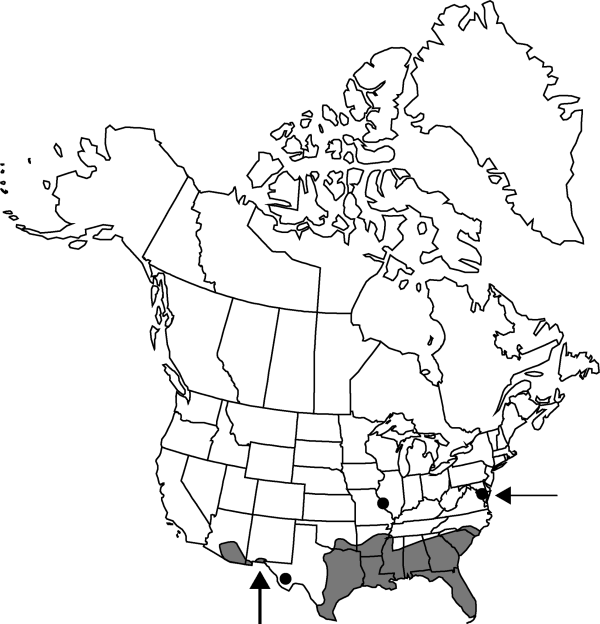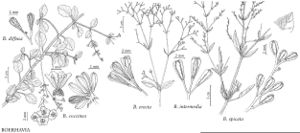FNA>Volume Importer |
FNA>Volume Importer |
| Line 17: |
Line 17: |
| | }}<!-- | | }}<!-- |
| | | | |
| − | --><span class="statement" id="st-d0_s0" data-properties="herb duration"><b>Herbs,</b> annual [slightly woody at base];</span> <span class="statement" id="st-d0_s1" data-properties="taproot shape;taproot texture;taproot texture">taproot tapered, soft or ± woody.</span> <span class="statement" id="st-d0_s2" data-properties="stem orientation;stem growth form or orientation;stem architecture;stem some measurement;stem pubescence;stem pubescence;stem pubescence;hair shape"><b>Stems </b>usually erect, sometimes decumbent, profusely branched primarily distally, 2–12 dm, minutely puberulent with bent hairs basally, usually glabrous, rarely sparsely puberulent distally.</span> <span class="statement" id="st-d0_s3" data-properties=""><b>Leaves </b>mostly in basal 1/2 of plant;</span> <span class="statement" id="st-d0_s4" data-properties="petiole atypical some measurement;petiole some measurement;blade shape;blade shape;blade shape;blade shape;blade shape;blade shape;blade shape;blade atypical length;blade length;blade width;adaxial surface pubescence;adaxial surface pubescence;adaxial surface coloration or relief;abaxial surface coloration;abaxial surface pubescence;abaxial surface pubescence;abaxial surface coloration or relief;patch size;cell coloration;base shape;base shape;base shape;margin shape;margin shape;apex shape;apex shape;apex shape">larger leaves with petiole 6–40 (–55) mm, blade broadly rhombic-ovate, triangular-ovate, ovate, oval, or lanceolate, 20–50 (–80) × 10–45 mm (distal leaves smaller, proportionately narrower), adaxial surface usually glabrous, sometimes minutely puberulent, usually minutely punctate, abaxial surface slightly paler than adaxial, usually glabrous, sometimes minutely puberulent, usually punctate with small patches of small brown cells, base obtuse to round, margins entire or sinuate, apex usually acute, less often obtuse or rounded.</span> <span class="statement" id="st-d0_s5" data-properties="inflorescence position or structure subtype;inflorescence shape;inflorescence size or quantity;inflorescence size or quantity;inflorescence size or quantity"><b>Inflorescences </b>terminal, forked ca. 4–6 times ± evenly, diffuse, usually with sticky internodal bands;</span> <span class="statement" id="st-d0_s6" data-properties="branch orientation;flower architecture;flower architecture;flower architecture;flower arrangement;pedicel architecture;pedicel architecture;pedicel architecture;pedicel arrangement;point architecture;point architecture;point architecture;point arrangement">branches strongly ascending, terminating in irregular umbellate or subracemose clusters of flowers, not all pedicels attaching at same point (flowers occasionally borne singly).</span> <span class="statement" id="st-d0_s7" data-properties="pedicel atypical some measurement;pedicel atypical some measurement;pedicel some measurement"><b>Flowers:</b> pedicel (0–) 0.3–2.5 (–5) mm;</span> <span class="statement" id="st-d0_s8" data-properties="bract shape;bract some measurement;base duration;base count;apex shape">bracts at base of perianth deciduous, usually 2, narrowly to broadly lanceolate, 0.5–1 mm, apex often acuminate;</span> <span class="statement" id="st-d0_s9" data-properties="perianth coloration;perianth coloration;perianth coloration;perianth coloration;perianth shape;perianth some measurement">perianth whitish, usually tinged with pink or purple [bright pink] between lobes and in tube, campanulate beyond constriction, 1–1.5 mm;</span> <span class="statement" id="st-d0_s10" data-properties="stamen count;stamen position">stamens 2–4, slightly exserted.</span> <span class="statement" id="st-d0_s11" data-properties="fruit count;fruit atypical count;fruit count;apex shape;apex shape;apex shape;apex pubescence"><b>Fruits </b>1–11 per cluster, pale greenish to straw colored or tan, narrowly obconic, (2.7–) 3–3.5 [–4] × 1.2–1.5 mm (l/w: (2–) 2.3–3.2), apex truncate or broadly low conic, glabrous;</span> <span class="statement" id="st-d0_s12" data-properties="fruit count;fruit shape;fruit relief;fruit arrangement;rib arrangement;rib coloration;rib coloration;rib coloration;rib coloration;rib shape;rib atypical length;rib atypical length;rib length;rib width;rib count">ribs 5, acute, slightly rugose adjacent to sulci;</span> <span class="statement" id="st-d0_s13" data-properties="fruit count;fruit dehiscence or orientation;fruit relief;fruit relief;sulcus arrangement;sulcus coloration;sulcus coloration;sulcus coloration;sulcus coloration;sulcus shape;sulcus atypical length;sulcus atypical length;sulcus length;sulcus width;sulcus width">sulci 0.5–1 times as wide as base of ribs, slightly to prominently coarsely transverse rugose, not papillate.</span><!-- | + | --><span class="statement" id="st-undefined" data-properties=""><b>Herbs,</b> annual [slightly woody at base]; taproot tapered, soft or ± woody. <b>Stems</b> usually erect, sometimes decumbent, profusely branched primarily distally, 2–12 dm, minutely puberulent with bent hairs basally, usually glabrous, rarely sparsely puberulent distally. <b>Leaves</b> mostly in basal 1/2 of plant; larger leaves with petiole 6–40(–55) mm, blade broadly rhombic-ovate, triangular-ovate, ovate, oval, or lanceolate, 20–50(–80) × 10–45 mm (distal leaves smaller, proportionately narrower), adaxial surface usually glabrous, sometimes minutely puberulent, usually minutely punctate, abaxial surface slightly paler than adaxial, usually glabrous, sometimes minutely puberulent, usually punctate with small patches of small brown cells, base obtuse to round, margins entire or sinuate, apex usually acute, less often obtuse or rounded. <b>Inflorescences</b> terminal, forked ca. 4–6 times ± evenly, diffuse, usually with sticky internodal bands; branches strongly ascending, terminating in irregular umbellate or subracemose clusters of flowers, not all pedicels attaching at same point (flowers occasionally borne singly). <b>Flowers</b>: pedicel (0–)0.3–2.5(–5) mm; bracts at base of perianth deciduous, usually 2, narrowly to broadly lanceolate, 0.5–1 mm, apex often acuminate; perianth whitish, usually tinged with pink or purple [bright pink] between lobes and in tube, campanulate beyond constriction, 1–1.5 mm; stamens 2–4, slightly exserted. <b>Fruits</b> 1–11 per cluster, pale greenish to straw colored or tan, narrowly obconic, (2.7–)3–3.5[–4] × 1.2–1.5 mm (l/w: (2–)2.3–3.2), apex truncate or broadly low conic, glabrous; ribs 5, acute, slightly rugose adjacent to sulci; sulci 0.5–1 times as wide as base of ribs, slightly to prominently coarsely transverse rugose, not papillate.</span><!-- |
| | | | |
| | -->{{Treatment/Body | | -->{{Treatment/Body |
| | + | |phenology=Flowering early summer-mid fall. |
| | |habitat=Disturbed areas, gardens, road and railroad rights-of-way, stream beds | | |habitat=Disturbed areas, gardens, road and railroad rights-of-way, stream beds |
| | |elevation=0-1700 m [probably much higher in tropics] | | |elevation=0-1700 m [probably much higher in tropics] |
| Line 39: |
Line 40: |
| | |basionyms= | | |basionyms= |
| | |family=Nyctaginaceae | | |family=Nyctaginaceae |
| | + | |phenology=Flowering early summer-mid fall. |
| | |habitat=Disturbed areas, gardens, road and railroad rights-of-way, stream beds | | |habitat=Disturbed areas, gardens, road and railroad rights-of-way, stream beds |
| | |elevation=0-1700 m [probably much higher in tropics] | | |elevation=0-1700 m [probably much higher in tropics] |
| Line 46: |
Line 48: |
| | |publication year=1753 | | |publication year=1753 |
| | |special status= | | |special status= |
| − | |source xml=https://jpend@bitbucket.org/aafc-mbb/fna-fine-grained-xml.git/src/287ef3db526bd807d435a3c7423ef2df1e951227/V4/V4_32.xml | + | |source xml=https://jpend@bitbucket.org/aafc-mbb/fna-data-curation.git/src/9216fc802291cd3df363fd52122300479582ede7/coarse_grained_fna_xml/V4/V4_32.xml |
| | |genus=Boerhavia | | |genus=Boerhavia |
| | |species=Boerhavia erecta | | |species=Boerhavia erecta |
| − | |abaxial surface coloration=slightly paler
| |
| − | |abaxial surface coloration or relief=punctate
| |
| − | |abaxial surface pubescence=puberulent;glabrous
| |
| − | |adaxial surface coloration or relief=punctate
| |
| − | |adaxial surface pubescence=puberulent;glabrous
| |
| − | |apex pubescence=glabrous
| |
| − | |apex shape=conic;low;truncate;acuminate;rounded;obtuse;acute
| |
| − | |base count=2
| |
| − | |base duration=deciduous
| |
| − | |base shape=obtuse;round
| |
| − | |blade atypical length=50mm;80mm
| |
| − | |blade length=20mm;50mm
| |
| − | |blade shape=lanceolate;oval;lanceolate;oval;ovate;triangular-ovate;rhombic-ovate
| |
| − | |blade width=10mm;45mm
| |
| − | |bract shape=lanceolate
| |
| − | |bract some measurement=0.5mm;1mm
| |
| − | |branch orientation=ascending
| |
| − | |cell coloration=small brown
| |
| − | |flower architecture=subracemose;umbellate;irregular
| |
| − | |flower arrangement=clusters
| |
| − | |fruit arrangement=adjacent
| |
| − | |fruit atypical count=2;2.3
| |
| − | |fruit count=1;11
| |
| − | |fruit dehiscence or orientation=transverse
| |
| − | |fruit relief=not papillate;rugose;rugose
| |
| − | |fruit shape=acute
| |
| − | |hair shape=bent
| |
| − | |herb duration=annual
| |
| − | |inflorescence position or structure subtype=terminal
| |
| − | |inflorescence shape=forked
| |
| − | |inflorescence size or quantity=4-6 times diffuse with sticky internodal bands;4-6 times diffuse with sticky internodal bands;4-6 times diffuse with sticky internodal bands
| |
| − | |margin shape=sinuate;entire
| |
| − | |patch size=small
| |
| − | |pedicel architecture=subracemose;umbellate;irregular
| |
| − | |pedicel arrangement=clusters
| |
| − | |pedicel atypical some measurement=2.5mm;5mm
| |
| − | |pedicel some measurement=0.3mm;2.5mm
| |
| − | |perianth coloration=purple;pink;tinged;whitish
| |
| − | |perianth shape=campanulate
| |
| − | |perianth some measurement=1mm;1.5mm
| |
| − | |petiole atypical some measurement=40mm;55mm
| |
| − | |petiole some measurement=6mm;40mm
| |
| − | |point architecture=subracemose;umbellate;irregular
| |
| − | |point arrangement=clusters
| |
| − | |rib arrangement=cluster
| |
| − | |rib atypical length=3.5mm;4mm
| |
| − | |rib coloration=pale greenish;straw colored or tan
| |
| − | |rib count=5
| |
| − | |rib length=3mm;3.5mm
| |
| − | |rib shape=obconic
| |
| − | |rib width=1.2mm;1.5mm
| |
| − | |stamen count=2;4
| |
| − | |stamen position=exserted
| |
| − | |stem architecture=branched
| |
| − | |stem growth form or orientation=decumbent
| |
| − | |stem orientation=erect
| |
| − | |stem pubescence=puberulent;glabrous;puberulent
| |
| − | |stem some measurement=2dm;12dm
| |
| − | |sulcus arrangement=cluster
| |
| − | |sulcus atypical length=3.5mm;4mm
| |
| − | |sulcus coloration=pale greenish;straw colored or tan
| |
| − | |sulcus length=3mm;3.5mm
| |
| − | |sulcus shape=obconic
| |
| − | |sulcus width=0.5-1 times as wide as base;1.2mm;1.5mm
| |
| − | |taproot shape=tapered
| |
| − | |taproot texture=woody;soft
| |
| | }}<!-- | | }}<!-- |
| | | | |
| | -->[[Category:Treatment]][[Category:Boerhavia]] | | -->[[Category:Treatment]][[Category:Boerhavia]] |
Herbs, annual [slightly woody at base]; taproot tapered, soft or ± woody. Stems usually erect, sometimes decumbent, profusely branched primarily distally, 2–12 dm, minutely puberulent with bent hairs basally, usually glabrous, rarely sparsely puberulent distally. Leaves mostly in basal 1/2 of plant; larger leaves with petiole 6–40(–55) mm, blade broadly rhombic-ovate, triangular-ovate, ovate, oval, or lanceolate, 20–50(–80) × 10–45 mm (distal leaves smaller, proportionately narrower), adaxial surface usually glabrous, sometimes minutely puberulent, usually minutely punctate, abaxial surface slightly paler than adaxial, usually glabrous, sometimes minutely puberulent, usually punctate with small patches of small brown cells, base obtuse to round, margins entire or sinuate, apex usually acute, less often obtuse or rounded. Inflorescences terminal, forked ca. 4–6 times ± evenly, diffuse, usually with sticky internodal bands; branches strongly ascending, terminating in irregular umbellate or subracemose clusters of flowers, not all pedicels attaching at same point (flowers occasionally borne singly). Flowers: pedicel (0–)0.3–2.5(–5) mm; bracts at base of perianth deciduous, usually 2, narrowly to broadly lanceolate, 0.5–1 mm, apex often acuminate; perianth whitish, usually tinged with pink or purple [bright pink] between lobes and in tube, campanulate beyond constriction, 1–1.5 mm; stamens 2–4, slightly exserted. Fruits 1–11 per cluster, pale greenish to straw colored or tan, narrowly obconic, (2.7–)3–3.5[–4] × 1.2–1.5 mm (l/w: (2–)2.3–3.2), apex truncate or broadly low conic, glabrous; ribs 5, acute, slightly rugose adjacent to sulci; sulci 0.5–1 times as wide as base of ribs, slightly to prominently coarsely transverse rugose, not papillate.
Phenology: Flowering early summer-mid fall.
Habitat: Disturbed areas, gardens, road and railroad rights-of-way, stream beds
Elevation: 0-1700 m [probably much higher in tropics]
Distribution
Ala., Ariz., Ark., Fla., Ga., La., Md., Miss., Mo., N.Mex., N.C., Okla., S.C., Tenn., Tex., Mexico, West Indies, Central America, South America, widely introduced throughout the tropics and warm-temperate regions.
Discussion
Boerhavia erecta occasionally forms mixed populations with B. intermedia without apparent intergradation. Rarely, some specimens seem to combine features of either species, particularly with regard to inflorescence structure. This is especially so in Sonora, Mexico, and in parts of the Sonoran Desert in Arizona. The two species bloom simultaneously and are visited by small insects. Given the presumed close relationship and weedy habitats of each, hybridization seems possible. Usually, the two species can be distinguished by the differences in fruit length, the appearance of a crownlike apex of the nearly mature fruits of B. erecta (apex of ridges slightly expanded, apex of fruit slightly conic), and the more precisely constructed terminal umbels of B. intermedia. Both species, particularly B. intermedia, may produce entire inflorescences with branches terminating in single flowers. R. E. Woodson Jr. and H. J. Kidd (1961) suggested that B. erecta hybridizes with the perennial B. diffusa.
Selected References
None.

